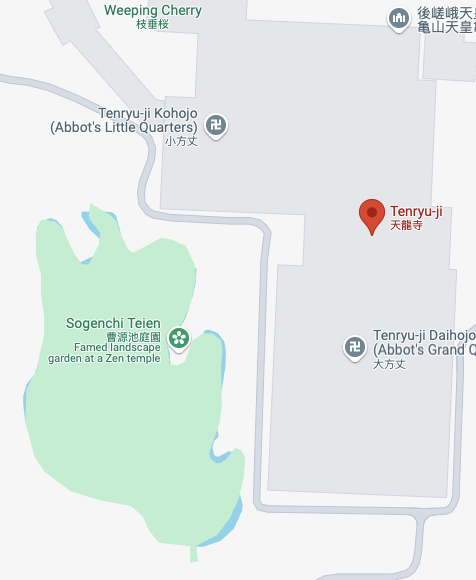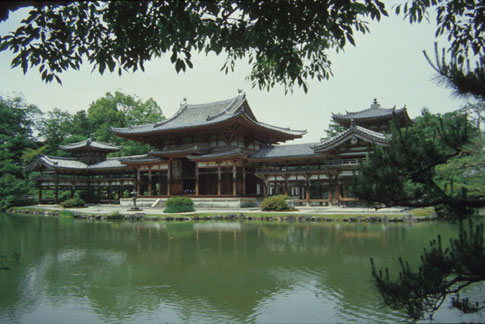
Tenryu-ji (Temple of the Heavenly Dragon) is located on the site of a villa erected for the Emperor Gosaga, who retired there in 1256. In 1339 the complex was converted to a Rinzai Zen temple, and under its first abbot, Muso Soseki, it became one of the five principal Rinzai temples of Kyoto. Its main feature is a relatively small pond garden featuring a famous rock arrangement located along its western shore. This group of stones consists of a cluster of rocks suggesting a mountainous island, a three-slab stone bridge established along the shore line, and a dry cascade constructed on the hillside just behind the bridge. Choose a view point from the map or click Tour the Garden for more views.
Tenryu-ji, Temple of the Heavenly Dragon, is located west of Kyoto in Arashiyama. It was built on the site of a villa erected for the Emperor Gosaga, who retired there in 1256 (the site had actually been occupied by Kyoto nobility since the ninth century). The villa was named Kameyama Dono (Mansion of the Turtle Mountain) after the mountain that forms a backdrop to the garden. In 1339 it was converted to a Rinzai Zen temple by the Shogun Ashikaga Takauji as an act of penance for having driven Emperor Godaigo into exile. Under its first abbot, Muso Soseki, who had prompted Takauji to make this act of attrition, the temple became one of the five principal Rinzai temples of Kyoto.
The buildings currently on the site all date from the late nineteenth or early twentieth century, but the pond garden and other landscape elements probably go back to the founding of the temple. The pond garden covers less than an acre. The pond itself, called Sogenchi or Sogen no ike, measures approximately 200 by 150 feet. It was intended to be contemplated from the temple buildings, and is famous for a rock arrangement located along its western shore. This grouping consists of a cluster of rocks suggesting a mountainous island, a three-slab stone bridge established along the shore line, and a dry cascade constructed on the hillside just behind the bridge. (The Kyoto Garden Book, published in 1830, describes the cascade as a functioning waterfall supplying the water of the pond.) Although this composition is widely considered to be the earliest extant attempt at imitating a full-scale landscape, there is no general agreement about its meaning or the identity of its designer. Assuming that the stones were placed there during Muso's term as abbot, there is the distinct possibility that the famous priest actually oversaw the construction of the garden. There is, however, no direct evidence of his involvement, and although he wrote about gardens, there is no evidence that he actually planned the ones with which he is associated. Those who assume that the island-bridge-waterfall combination was intended to evoke a Chinese landscape painting typical of the Song Dynasty wonder if a Chinese painter, or possibly a Chinese immigrant priest, could have been responsible for the design. It is true that the zealous importing of Song landscape paintings postdates the building of this garden, but considering how many works of art have been destroyed by fires in Japan, one can not rule out the possibility that a Japanese artist or artisan knew the Song "formula" for vertical landscape paintings and designed Tenryu-ji accordingly.
That the rocks are intended to represent a landscape in miniature is supported by the writings of Muso and his followers, who often refer to scenic vistas as similar to painted landscapes. The idea actually harks back to Heian texts: the Tale of Genji refers to a garden rock as resembling an element in a painting. But the specific identification of the island group and its dominant stone is a matter of debate: is it intended to represent the Buddhist Mt. Sumeru, or Peng Lai (the Japanese Horai), or the major peak of the Daoist "Isles of the Blest"? And finally, how many of the other elements of the garden can be thought to reflect the original scheme? Whatever one's interpretation of this famous complex, it must be considered one of the earliest gardens to be associated with a Zen temple, and ranks with Saiho-ji in that regard. It is also the earliest extant example of a "mock landscape," to use Wybe Kuitert's translation of the Japanese term kasenzui.

